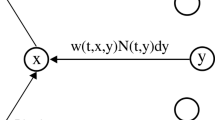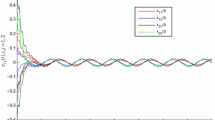Abstract
Networks of mutually inhibiting neurons are analyzed and simulated on a digital computer. In the analysis and simulation a continuous-variable model of the neuron is used as the basic element. It consists of a many-input adder, a first-order low-pass filter and a diode-type nonlinearity. A mutually inhibiting network is formed by connecting the output of every element to inputs of the other elements through weight-coefficient setting units. Each element of the network is assumed to receive a certain number of constant inputs from elements of other networks.
An autonomous system of nonlinear differential equations is introduced to describe the network dynamics, and the steady-state solutions of the system are investigated in detail. The network has a unique equilibrium solution, multiple equilibrium solutions or a periodic solution depending on the weight-coefficients and the inputs. It is shown that these three cases correspond to three types of information processing functions: the sharpening of input patterns, the temporary storage of information and the generation of periodic signals.
Similar content being viewed by others
References
Dusheck,G.J.: A flexible neural logic network. IEEE Trans. Military Electronics, MIL-7, 208–213 (1963).
Fukushima,K.: Visual feature extraction by a multilayered network of analog threshold elements. IEEE Trans. System Science and Cybernetics, SSC-5, 322–333 (1969).
Grossberg,G.: Embedding fields: A theory oflearning with physiological implications. J. Math. Psych., 6, 209–239 (1969).
— Neural pattern discrimination. J. Theoret. Biol., 27, 291–337 (1970).
Harmon,L.D.: Neuromimes; action of a reciprocally inhibiting pair. Szience 146, 1323–1325 (1964).
Kling,U., Székely,G.: Simulation of rhythmic nervous activities. Kybernetik 5, 89–103 (1968).
Reichardt,W. von, Ginitie,G.M.: Zur Theorie der lateralen Inhibition. Kybernetik 1, 155–165 (1962).
Reiss,R.F.: A theory and simulation of rhythmic behavior due to reciprocal inhibition in small nerve nets. Proc. 1962 AFIPS
Spring Joint Computer Conference, 171–193 (1962).
Suzuki,R.: Dynamics of “Neuron Ring”. Kybernetik, 8, 39–45 (1971).
Varjú,D. von: Vergleich zweier Modelle für laterale Inhibition. Kybernetik 1, 200–208 (1962).
Wilson,D.W., Waldron,I.: Models for the generation of the motor output pattern in flying locusts. Proc. IEEE 56, 1058–1064 (1968).
Author information
Authors and Affiliations
Rights and permissions
About this article
Cite this article
Morishita, I., Yajima, A. Analysis and simulation of networks of mutually inhibiting neurons. Kybernetik 11, 154–165 (1972). https://doi.org/10.1007/BF00270672
Received:
Issue Date:
DOI: https://doi.org/10.1007/BF00270672




